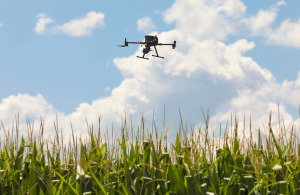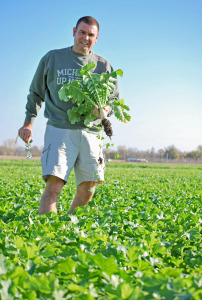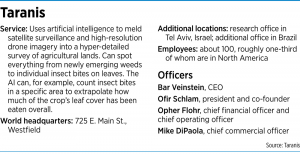Subscriber Benefit
As a subscriber you can listen to articles at work, in the car, or while you work out. Subscribe Now
Farmer Dave Chance regularly walks his fields, scouting for problems ranging from pest infestations to nutritional shortcomings to weeds. It’s a practice followed by farmers since time immemorial. But Chance doesn’t do quite as much of it as he once did. These days, he’s got drones for that.
Three years ago, he enlisted the services of Westfield-based agricultural monitoring service Taranis. Founded in Israel, the company moved its headquarters to Indiana in 2020. It uses AI to comb both satellite imagery and extremely high-resolution field photos taken during regular drone overflights to locate and diagnose pretty much any imaginable threat to its customers’ farmland.
Chance’s spread, based in Lebanon and named Chance Farms, grows about 2,200 acres of corn, soybeans and wheat on parcels spread around Boone, Hamilton and Clinton counties. It’s a lot to keep track of. Especially if you do it the old-fashioned way, by regularly scouting the fields on foot.

“Scouting fields is very important in terms of actually knowing what’s going on, and you need to physically walk every field to do that accurately,” Chance said. “It’s a very large time commitment. I might be able to physically walk 400 acres a day.”
Turns out Taranis’ drones can do it better. A lot better.
Chance holds a 220-acre parcel in Clinton County that sees regular infestations of a weed known as barnyard grass. In previous years, he or someone else would monitor the field on foot to determine if the problem warranted an herbicide application. Last year, after a cursory patrol, the problem seemed negligible.
“We didn’t really see a whole lot going on,” Chance said. “We would walk out into the field, and we just weren’t seeing the weed pressure.”
The data they received from Taranis’ next drone overflight proved them wrong. The photos, which are so high-resolution that one can see individual bites taken out of individual leaves by insects—showed a randy outbreak of barnyard grass gaining a foothold in one corner of the property. The precise application of herbicide ended the problem and saved Chance Farms a considerable amount of money.
“That was really kind of an ‘ah-ha’ moment for us,” Chance said. “I think the whole program last year cost us around $14,000. But if those weeds hadn’t been spotted, it would have caused perhaps a 15- to 20-percent yield reduction in that area. All that was accomplished with just one flight, and one image of one field. It not only paid for itself, but we felt like it was a 4-to-1 return.”
Growing market
Taranis is part of a new but rapidly growing industry offering agricultural mapping services. Numerous companies, from tiny startups to agribusiness titans such as John Deere, use some combination of airplane or drone overflight services and advanced information processing to monitor vast swaths of cropland in minute detail, helping landowners maximize yields by closely watching everything from fertilizer levels to pest infestations. The global precision farming market is predicted to reach $11.1 billion by 2027.
Taranis was established in 2015. Co-founder and current president Ofir Schlam is both a fourth-generation member of an Israeli farm family and a military veteran who, according to Taranis’ website, has degrees in math, computer science and cryptography; served in an “elite technological unit;” and “developed and led groundbreaking technology for classified projects.” Other members of the management team include CEO Bar Veinstein and CFO and COO Opher Flohr.

Taranis’ day-to-day headquarters operations are overseen by Mike DiPaola, chief commercial officer. He said the company’s move from Tel Aviv to central Indiana isn’t that hard to understand, given that it coveted entry into the U.S. market. At first, it contemplated sites such as Chicago (because it had a big airport and because the Taranis team was familiar with the area) and Raleigh-Durham, North Carolina.
“We looked at factors like agribusiness capabilities, agronomy, talent, land grant universities, economic freedom and cost of living,” DiPaola said. “When we scored all the analyses, there wasn’t a better place to do business than Indiana.”
It also probably didn’t hurt that the state had courted the company for two years.
The pursuit began in 2018 with a trade mission to Israel led by Gov. Eric Holcomb. One of the folks accompanying him was Mitch Frazier, currently CEO of AgriNovus Indiana, which promotes the state’s agribioscience industry. At the time, however, he was CEO of Reynolds Farm Equipment and somewhat new to the trade-mission game. While compiling a Google-assisted list of Israeli ag tech companies, he happened upon Taranis and tried to contact its CEO.
“I just started guessing his email address,” Frazier recalled. “I sent probably dozens of permutations of his name and the company name. One finally went through, and he responded and said that he’d love to meet with our team.”
Holcomb and his entourage did, indeed, meet with Taranis management in Tel Aviv and began negotiations that would bear fruit a couple of years later.
“Ultimately, we were able to secure their investment here in Indiana for 2020,” Frazier said.
Ag-tech ecosystem
Though Indiana is quite well-known as a farm-intensive state, it wasn’t that factor alone that lured the company.
“It’s not about, ‘Hey, move to Indiana.’ It’s about what challenges they have,” Frazier said. “What problems we can help them solve. We have a tremendous group of ag bioscience leaders, from Beck’s Hybrids in Atlanta, Indiana [a retail seed company] to Corteva Agriscience in Indianapolis [an agricultural and seed company]. There’s so many leaders who care about innovation. We have this tremendous resource in software as a service here.”

In other words, Indiana offered an already-established ag-tech ecosystem in which Taranis might thrive. It’s a view with which Westfield Mayor Andy Cook concurs.
“Obviously, Indiana is a prime spot when you’re interested in the merger of technology and agriculture,” Cook said. “It fits right in with what Westfield is trying to do, with our quest to attract what’s called advanced manufacturing.”
Especially agriculture-related enterprises. Cook said he’s worked closely with Frazier at AgriNovus to put together deals similar to the one with Taranis.
For its part, Taranis predicted it would bring “as many as” 60 high-paying jobs to the area by 2023. The Indiana Economic Development Corp. offered Taranis as much as $1.25 million in conditional tax credits, pegged to meeting those hiring goals.
“We have nearly 100 employees worldwide, and roughly a third of those are in the U.S.,” DiPaola said. “We’ll be doubling our U.S. sales force this year, so we’ll be adding significantly to those numbers.”
While the Westfield office serves as the company’s global headquarters, it still maintains its Tel Aviv research hub. There’s also an office in Brazil.
The company already has around 20 million acres of farmland under observation in locations ranging from Kazakhstan to Australia to Germany, and approximately 19,000 customers globally. Some, however, are quite close to home.
High-resolution imagery
Don Lamb, owner of Lebanon-based Lamb Farms, also has seen the benefit of examining his croplands in almost forensic detail. Especially since the sheer scope of his operation makes walking every acre next to impossible. Though he’s shy about saying just how many acres he farms, suffice it to say that he holds acreage in Boone, Montgomery, Clinton and Hamilton counties that, together, is far more land than 5,400-acre Eagle Creek Park. All of it is covered in corn, soybeans and wheat.
Lamb experimented with farm drones and saw glimpses of their potential.
“But we’d never really been able to point to something that we thought would give us a financial return,” he said.
What made him a Taranis believer was the high-resolution images the service offered, and the way the information was processed by AI to create highly specific plans of action.
“The detail of the pictures is incredible,” Lamb said. “Just being able to see so much detail, right down to the square inch, was incredible.”
Lamb has Taranis fly his field three times a year. The first pass happens at the start of the growing season and helps spot any portions of the acreage where germination wasn’t successful, in time to replant. The next pass, a few weeks later, primarily looks for developing weed problems. The fidelity of the images is so precise that the system’s AI can identify the species of weed and the area it’s invaded.
“You know what kind of weed it is and what kind of herbicide to use to kill it,” he said. “You take that information and download it to your sprayer, so that it will only spray where the weeds are. You don’t have to spray the whole field to get the weed.”
The third pass takes place around the time the corn sets tassels and the soybeans flower, when the drones look for diseases like fungus infestations. Again, the Taranis data tells precisely where to spray, saving money and time.
Lamb can’t say exactly how much cash the system has saved him, because this is only his second season using Taranis.
“We’re still getting used to it,” he said. “I don’t know if I can point to an exact return we got from it. But I can say that, with commodity prices where they are now, if you can save just a bushel or two of your per-acre yield, then the whole service could be paid for in one year.”
Still, in his mind, there’s no substitute for walking the fields. At least, not quite yet.
“I don’t think a farmer is ever going to get away from walking around and really looking at what’s going on in detail,” Lamb said. “It might not be as practical as letting a drone do it, but it’s in our blood.”•
Please enable JavaScript to view this content.

